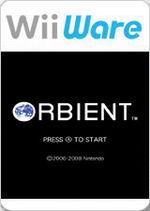- Orbient
-
Orbient 
The WiiWare image for Orbient.Developer(s) skip Ltd. Publisher(s) Nintendo Platform(s) Game Boy Advance, Wii (WiiWare) Release date(s) Game Boy Advance
- JP July 27, 2006
Genre(s) Puzzle Mode(s) Single-player Rating(s) Orbient, known in Japan as Orbital, is a puzzle video game developed by skip Ltd. and published by Nintendo for the Wii's WiiWare digital distribution service. It is one of seven games in the Art Style series of video games available for WiiWare and DSiWare. It is a remake of a Japan-only Game Boy Advance video game titled Orbital, released for the bit Generations series of video games.[1]
The objective of Orbient is to control a white star which grows larger by absorbing blue stars and collecting smaller gray stars to form orbiting satellites.
While the original bit Generations version was met with mixed reactions,[2] The WiiWare version of Orbient was very well received, holding an average score of 82.3% and 82/100 from Game Rankings[citation needed] and Meta Critic respectively.[citation needed]
Contents
Gameplay
In Orbient, players control a white star. The game starts with the white star able to take 5 hits before it is destroyed. To make it grow, the player must collide his/her star with a similar-sized, blue star. Stars smaller than the player's star are gray-colored. Colliding with these stars will not change the white star's size, but if the player positions the white star just right, the gray star will orbit the white and become a satellite. Red stars are bigger than the white. The white star is able to orbit red stars to help travel through space. Whenever the white star grows large enough, the target star glows orange, and is able to be a satellite; as soon as that happens, a small crescent star appears, and having it successfully orbit the white star will give the player bonus points, (and collecting all different crescent stars unlocks new galaxies and are the goal to complete the game 100%). Colliding with the orange star will take away a hit, but having it orbit the white star will clear the round. The player guides the star by pressing the A and B buttons on the Wii Remote to utilize gravity and anti-gravity, respectively, and attract it towards or repel against (also respectively) the gravitational wells of celestial objects. Players must be careful not to crash their star into the red stars or floating objects like asteroids, or be sucked into black holes, which takes away a hit (and in the case of black holes, restart the entire stage).
Scoring
At the end of each round, the player gets scored on the number of stars consumed or collected as satellites, bonus points for clearing the stage with a time faster than the set "official time", and bonus points for collecting the crescent star as a satellite, and adds it to the total. Times or total scores that shows in red are new records. Satellites, including the orange and crescent stars, are then converted into extra hits for the next stage.
Development
Orbient was originally released for the Game Boy Advance as Orbital under the bit Generations label on July 27, 2006 exclusively in Japan. This version was announced on June 1, 2006. Nintendo announced that they would be giving free copies of the games in the series to 700 members of the Club Nintendo web site in exchange to feedback on them, though only to people who own a Game Boy Advance or Nintendo DS.[3] Nintendo filed for an ESRB rating for this title in the US.[citation needed] It was later remade for the Wii's WiiWare service in the Art Style series. Both versions were developed and published by skip Ltd. and Nintendo respectively.[citation needed]
Reception
The bit Generations version of Orbient received mixed scores from Famitsu, receiving a 7/9/6/7 from them.[2] The WiiWare version was more well-received, average score of 82.3% and 82/100 on Game Rankings[citation needed] and Meta Critic respectively.[citation needed] IGN praised the simplicity of the gameplay and the improvements made to the original, and called it "an incredibly mellow, relaxing experience", yet at the same time "one of the most challenging games you'll ever play".[1] GameSpot found the physics-based puzzles to be clever, but criticized it for lacking that "must-play, addictive appeal" and for its lackluster presentation.[citation needed] EuroGamer called it a quietly brilliant game, and called it the most interesting and rewarding of the three WiiWare games released so far.[citation needed] It was nominated for multiple Wii-specific awards from IGN in its 2008 video game awards, including Best Action Game[4] and Most Innovative Design.[5]
References
- ^ a b IGN: Orbient Review
- ^ a b "Notes Famitsu". Gamekyo. 2006-07-19. http://www.gamekyo.com/news16673_notes-famitsu.html. Retrieved 2009-01-29.
- ^ "Nintendo preps GBA bit Generations series". GameSpot. 2006-06-01. http://www.gamespot.com/news/6152192.html. Retrieved 2009-01-29.
- ^ "IGN Wii: Best Action Game 2008". IGN.com. 2008-12-18. http://bestof.ign.com/2008/wii/1.html. Retrieved 2008-12-19.
- ^ "IGN Wii: Most Innovative Design 2008". IGN.com. 2008-12-18. http://bestof.ign.com/2008/wii/24.html. Retrieved 2008-12-19.
External links
Skip Ltd. games Chibi-Robo! series Art Style series WiiWareDSiWareRelatedOther games Categories:- 2006 video games
- Game Boy Advance games
- Skip Ltd. games
- Puzzle video games
- WiiWare games
- Wii games
Wikimedia Foundation. 2010.
